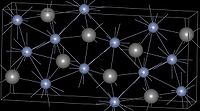- Chromium carbide
-
Chromium carbide[1]  Chromium(II) carbide
Chromium(II) carbideIdentifiers CAS number 12012-35-0 
PubChem 3650773 ChemSpider 21171152 
Jmol-3D images Image 1 - [Cr]#C[Cr]C#[Cr]
Properties Molecular formula Cr3C2 Molar mass 180.009 g/mol Appearance gray orthorhombic crystals Density 6.68 g/cm3 Melting point 1895°C
Structure Crystal structure Orthorhombic, oP20 Space group Pnma, No. 62  carbide (verify) (what is:
carbide (verify) (what is:  /
/ ?)
?)
Except where noted otherwise, data are given for materials in their standard state (at 25 °C, 100 kPa)Infobox references Chromium carbide (Cr3C2) is an extremely hard refractory ceramic material. It is usually processed by sintering. It has the appearance of a gray powder with orthorhombic crystal structure. The orthorhombic Cr3C2 occurs extremely rarely as mineral tongbaite.
Other compositions are available, e.g. Cr23C6 (occurring as extremely rare mineral isovite, cubic) and Cr7C3.
Contents
Properties
It is highly corrosion-resistant, and does not oxidize at high temperatures (1000-1100 °C). The powder for coating costs $40–$65 per pound.
The thermal expansion coefficient of chromium carbide is almost equal to that of steel, reducing the mechanical stress buildup at the layer boundary.
Precipitation of chromium carbide at the grain boundaries, depleting the grain edges of chromium, is the cause of intergranular corrosion of stainless steel near the welds.
Uses
Chromium carbide is used as a thermal spray material for protecting the underlying metal surface, and as an additive to corrosion-resistant and wear-resistant materials. It is used in coatings of bearings, seals, orifices, and valve seals, and as a fine-crystal phase in other sintered carbides, where, like the vanadium carbide, it inhibits growth of submicrometre grains during pressing and sintering.
It is also used as a material for gage block standards, used in metrology. Chromium carbide is widely used by Starrett-Webber gage block tolerances, with a thermal expansion coefficient of 4.7 x 10^-6 inches/foot per inch.
References
External links
Chromium compounds Categories:- Carbides
- Chromium compounds
- Superhard materials
- Refractory materials
- Inorganic compound stubs
Wikimedia Foundation. 2010.
